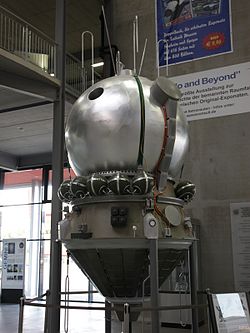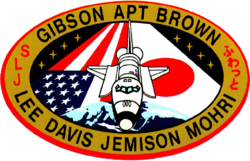STS-47
| STS-47 | |||||
 | |||||
| Uppdrag | 50 | ||||
|---|---|---|---|---|---|
| Rymdfärja | Endeavour (2)[1] | ||||
| NSSDC-ID | 1992-061A[2] | ||||
| Färdens tid | 7 dagar, 22 timmar, 30 minuter, 23 sekunder | ||||
| Uppskjutning | |||||
| Startplats | Startplatta 39B vid Kennedy Space Center i Florida | ||||
| Start | 12 september 1992, 10:23:00.0680 a.m. EDT. | ||||
| Landning | |||||
| Landningsplats | Runway 33, KSC | ||||
| Landning | 20 september 1992, 8:53:24 a.m. EDT | ||||
| Omloppsbana | |||||
| Varv | 126 st[3] | ||||
| Apogeum | 310 km | ||||
| Perigeum | 297 km | ||||
| Banlutning | 57° | ||||
| Sträcka | 5,266 miljoner km | ||||
| Besättning | |||||
| Befälhavare | Robert L. Gibson (4) | ||||
| Pilot | Curtis L. Brown (1) | ||||
| Uppdragsspecialister | Jan Davis (1) Jay Apt (2) Mae C. Jemison (1) | ||||
| Nyttolastspecialister | Mark C. Lee (2) Mamoru Mohri (1) Japan | ||||
 | |||||
| Kronologi Rymdfärjeprogrammet | |||||
| |||||
STS-47 var den femtionde flygningen i det amerikanska rymdfärjeprogrammet, den andra flygningen med rymdfärjan Endeavour. Den sköts upp från Pad 39B vid Kennedy Space Center i Florida den 12 september 1992. Efter nästan åtta dagar i omloppsbana runt jorden återinträdde rymdfärjan i jordens atmosfär och landade vid Kennedy Space Center.
Se även
Referenser
- ^ NASA Space Shuttle Launch Archive Arkiverad 9 augusti 2020 hämtat från the Wayback Machine., läst 28 juli 2016.
- ^ ”NASA Space Science Data Coordinated Archive” (på engelska). NASA. https://nssdc.gsfc.nasa.gov/nmc/spacecraft/display.action?id=1992-061A. Läst 19 mars 2020.
- ^ Manned Astronautics - Figures & Facts Arkiverad 16 augusti 2016 hämtat från the Wayback Machine., läst 28 juli 2016.
Externa länkar
 Wikimedia Commons har media som rör STS-47.
Wikimedia Commons har media som rör STS-47.
| ||||||||
| ||||||||||||||||||||||||||||||||
Media som används på denna webbplats
STS-47 crewmembers assemble for their traditional onboard (in-flight) portrait in the Spacelab Japan (SLJ) science module aboard the Earth-orbiting Endeavour, Orbiter Vehicle (OV) 105. Left to right (front) are Mission Specialist N. Jan Davis, MS and Payload Commander (PLC) Mark C. Lee, and Payload Specialist Mamoru Mohri; and (rear) Pilot Curtis L. Brown, Jr, MS Jerome Apt, Commander Robert L. Gibson, and MS Mae C. Jemison.
STS-52 Columbia, Orbiter Vehicle (OV) 102, crew insignia (logo), the Official insignia of the NASA STS-52 mission, features a large gold star to symbolize the crew's mission on the frontiers of space. A gold star is often used to symbolize the frontier period of the American West. The red star in the shape of the Greek letter lambda represents both the laser measurements to be taken from the Laser Geodynamic Satellite (LAGEOS II) and the Lambda Point Experiment, which is part of the United States Microgravity Payload (USMP-1). The LAGEOS II is a joint Italian \ United States (U.S.) satellite project intended to further our understanding of global plate tectonics. The USMP-1 is a microgravity facility which has French and U.S. experiments designed to test the theory of cooperative phase transitions and to study the solid\liquid interface of a metallic alloy in the low gravity environment. The remote manipulator system (RMS) arm and maple leaf are emblematic of the Canadian payload specialist Steven MacLean.
STS-46 Mission Insignia
Författare/Upphovsman: Pascal (Flickr user: pasukaru76), Licens: CC0
Vostok spacecraft replica at the Technik Museum Speyer, Germany.
The mission emblem of STS-47 depicts the Space Shuttle Orbiter with the Spacelab module in the cargo bay against a backdrop of the flags of the United States and Japan, symbolizing the side-by-side cooperation of the two nations in this mission. The land masses of Japan and Alaska are represented on the emblem emphasizing the multi-national aspect of the flight as well as the high inclination orbit of 57 degrees. The initials `SLJ' on the left border of the emblem stand for Spacelab Japan, but the name generally used for the mission is `Spacelab-J.' The Japanese characters on the right border form the word `Fuwatto' which is the Japanese word for weightlessness.






